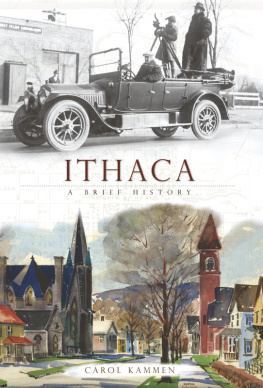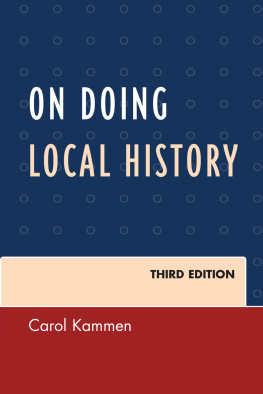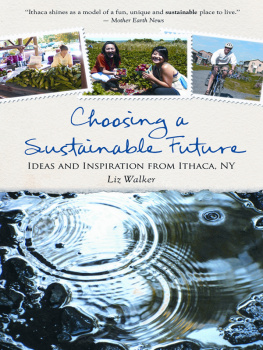

Published by The History Press
Charleston, SC 29403
www.historypress.net
Copyright 2008 by Carol Kammen
All rights reserved
First published 2008
Second printing 2010
e-book edition 2011
ISBN 978.1.61423.067.0
Library of Congress Cataloging-in-Publication Data
Kammen, Carol, 1937
Ithaca : a brief history / Carol Kammen.
p. cm.
print edition ISBN 978-1-59629-515-5
1. Ithaca (N.Y.)--History. I. Title.
F129.I8K248 2008
974.771--dc22
2008038823
Notice: The information in this book is true and complete to the best of our knowledge. It is offered without guarantee on the part of the author or The History Press. The author and The History Press disclaim all liability in connection with the use of this book.
All rights reserved. No part of this book may be reproduced or transmitted in any form whatsoever without prior written permission from the publisher except in the case of brief quotations embodied in critical articles and reviews.
For Dele and Henny, the two wonderful women who have become my daughters, and for the women in Ithaca who talk, walk, read and lunch with me: Elizabeth, Joan, Karen, Lauris, Lizzy, Martha, Mary, Melissa, Miriam, Nina, Norma and Scobie.
C ONTENTS
A CKNOWLEDGEMENTS
I owe my greatest thanks to my husband, Michael, a true partner in this and in so many other things. I treasure his knowledge, judgment and patience. I am especially grateful to Robert Kibbee, curator of maps at Cornell University for his knowledge of local maps and permission to reproduce a number of them here, and to Howard Brentlinger and Nij Tontisirin Anantsuksomsri for scanning the images used throughout the book. Another important source of images was Bill Hecht, who has put much local material on the Internet.
I appreciate the support given to this project by Mayor Carolyn Peterson, Annie Sherman, Leslie Chatterton and Sue Kittel in City Hall. Many others have offered information: James Brown and Samantha Smith, Shawn Galbreath, Brett Bossard, Lenore Schwager, Ann Rider, Jennifer Streid-Mullen, Catherine Wedge, Jim Johnson, Deborah Dietrich, David Smith, Carman Hill, Dan Maas, Hunter Rawlings, Scott Heyman, Peggy Hill, Patricia Dunn, Robin Schwartz, Greg Trembly, Marcia Lynch, Nancy Schuler, Walter Lynn, John Marcham and Sharon Yntema. Also, I appreciate the aid of Laura Owens, of the Tompkins County Board of Elections, and Norma Manning, the Cayuga Heights village clerk.
I am very grateful to Raymond Wheaton and the Ithaca Veteran Volunteer Firemans Association, which owns the Ithaca Fire Banner, for allowing me to reproduce it, and to Donna Eschenbrenner, of the History Center, who arranged for the scan.
Chris OConnor conducted some research quoted in the text. Throughout, I have attempted to indicate the source of direct quotations, and I have cited the books upon which I have relied. The most important documents are the records kept by the Village and City of Ithaca, the Ithaca Journal, the Ithaca Democrat and personal memoirs. See also my books Peopling of Tompkins County (Interlaken, 1985), What they Wrote: 19th Century Documents from Tompkins County, New York (Ithaca, 1978) and Cornell: Glorious to View (Ithaca, 2003). Especially valuable are Ithacas Neighborhoods: The Rhine, The Hill, and The Goose Pasture (Ithaca, 1988), edited by Carol U. Sisler, Margaret Hobbie and Jane Marsh Dieckmann; Daniel R. Snodderlys Ithaca and Its Past (Ithaca, 1982); Thomas W. Burnss Initial Ithacans (Ithaca, 1904); and Henry E. Abts Ithaca (Ithaca, 1926). Other sources are named in the text. I have also relied on the state and federal censuses.

An 1897 view from the Trumansburg Road, showing swamps, the jetty at the inlet and the dock at Renwick Park. Collection of the Tompkins County Historian 20.6.
Part I
B EING AND B ECOMING
On a Saturday in June 2008, as I neared the far end of the Farmers Market, the man from Littletree Nursery emerged from the side of his truck. He held cherries, both sour and sweet, in his outstretched hands. He sighed with a degree of awe and satisfaction and proclaimed to any- and everyone: Welcome to another day in paradise.
There is the contradiction, the irony. In Ithaca, there is the sour amidst the sweet. We like to say that Ithaca is ten square miles set in the midst of reality; the lake and hills, cut through with deep streams, are stunning to behold, but Ithaca has also been prone to deadly flooding. In the same way, Ithacas cultural offerings flourish, but its many performing groups are not particularly well funded. Ithaca is an educated community, but there is poverty of hope and ambition here, too. Ithacas population is diverse, but there are racial tensions, and, over time, newcomers have not always been graciously welcomed. Ithaca is liberal, but those who think conservatively also live here. Ithaca is generous to its causes but had to learn to understand the needs to be found in its midst. Ithaca is organized, but perhaps over organized. Ithaca stands out politically and economically from the surrounding region; it has low unemployment, but also low wages for its educated workforce. Ithaca celebrates and promotes itself as a destination, but it has always been a fluctuating place with much coming and going. Ithacans complain about the students, but those who come to learn here enliven our cultural lives, and education is our largest business. Ithaca has grown, but that growth in population has been slow and uneven. Ithaca is a small city divided into many different communities, with multitudes of opinions, groups and sentiments. Everyone in Ithaca has an opinion about just about everything. Ithaca might be said to be in the region of the Finger Lakes, but it is not quite representative of it. Ithaca stands apart. And it is so Ithaca to think so.
Ithacas landscape was created by the activity of glaciers that carved out the lake and funneled water through Fall Creek, Cascadilla and Six Mile Creek. These streams cut through East Hill, leaving wedges of land like cake slices standing on a plate. This book also cuts Ithacas history into thirds. The first is the period of settlement through the anxious early years to 1870; the second, a time of organization and diversification leading through the twentieth century to 1975; and the third, the past that was yesterday, which looks at our own time. Throughout, the topics that concern me are the things that shape life here: the landscape, government and our institutions of higher education. I am also interested in the growth of Ithacas population and its diversity, our response to those in need and how we came to understand that not everyone is healthy, wealthy and wise. I am also concerned with the ways in which technology has changed life here, and how the rich cultural life we enjoy today came about. While much history is written in terms of forces and groups, in Ithaca we have also been shaped and enriched by individuals who have made a difference. The man at the Farmers Market was wrong, of course, because this is not paradise, but, at the same time, he had it absolutely right.

Next page













